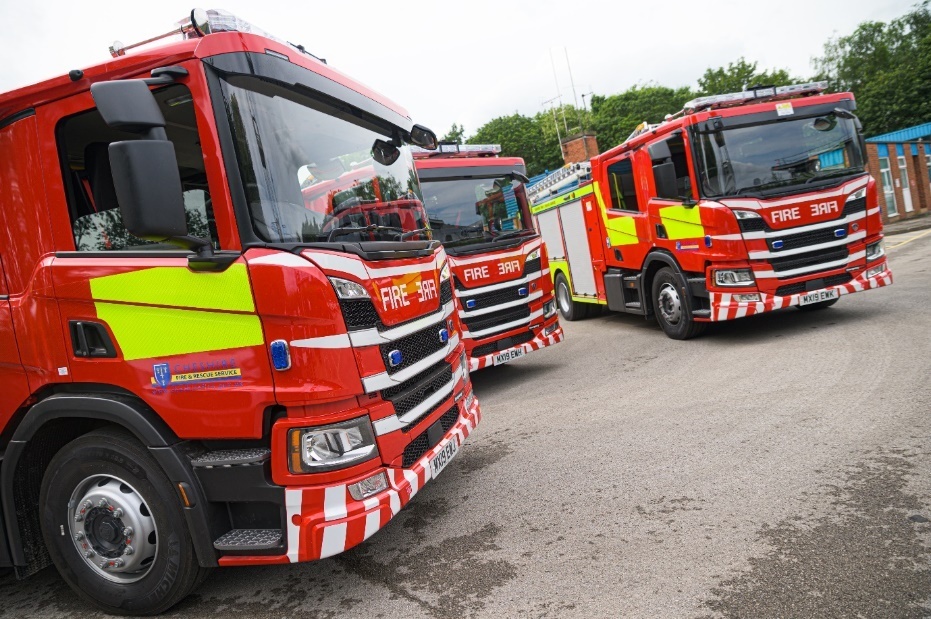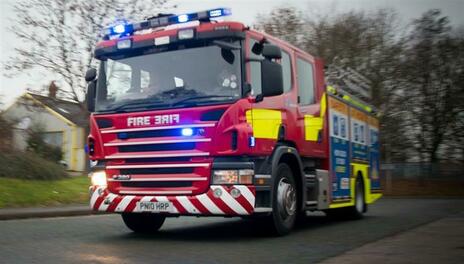- About Us
- Local Fire Stations
- Vehicles

This page contains information about the emergency vehicles used by Cheshire Fire and Rescue Service.
Since 2010 CFRS has tried to standardise the operational fleet moving to Scania 18T chassis cabs. Prior to this various chassis cabs have been procured resulting in the fleet being varied and more difficult to maintain.

Based on the latest generation of Scania 18T chassis and working with firefighters the latest appliance has evolved.
Looking to reduce the contaminates that get moved into the cab area following Breathing Apparatus (BA) use, two of the four sets have been moved external to the vehicle.
Due to the introduction of euro six engines, locker space and cab space needed to be redesigned.
This resulted in a pull out slide locker being introduced behind the cab to accommodate the majority of hand tools.


In an attempt to standardise the fleet, from 2010 Scania 18T chassis cabs have been procured.
MAN Plastisol vehicles. Three of the four procured remain on the run, with the fourth now being used as our rainbow fire engine (details below)


Mercedes Atego remain in the operational fleet, but are now just starting to be moved into the spare vehicle fleet as detailed below.
Still in operational service the 1999 fleet of Dennis Sabre XL’s form the majority of the ‘spare’ appliance fleet.
These vehicles allow the current front line capability to be maintained, whist service and maintenance is carried out. These vehicles are now coming off the fleet.


Aerial Ladder Platforms (ALP) are used for high-rise rescues. Based on Scania 26T rear steer chassis they have the capability to get into the majority of areas required. With a 500kg cage, the vehicle can be used to rescue personnel, deploy rescue boats or utilised by the technical rescue team to abseil from if required.
In addition, they can also be used as a water tower with water being pumped from a supporting fire appliance. The vehicle has an operating height of 32m, thermal and optical cameras and has piped BA to the cage to enhance fire fighter safety.
Based at Macclesfield Fire Station the High Reach Extending Turret (HRET) Scorpion is the main fire engine deployed to all incidents. In addition to operating as a regular fire engine, the HRET also has a 20m water tower boom with an 80m range. Carrying all the equipment of a conventional fire engine with the exception of the 13.5m and roof ladders, the HRET is a highly versatile asset to the Service.
With a 4010 Godiva pump, 1800 litres of water and 150 litre foam capacity, the HRET can pierce building roof structures, industrial buildings and cars etc with its piercing tool, jetting water into the structure without the need to commit firefighters. Alternatively it can utilise its water monitor for open areas for water or foam deployment. Fitted with thermal optical cameras, it allows Incident Commanders a ‘birds eye’ view of what they are dealing with.


On-call fire stations have all now been issued with 2.4l Toyota Hilux Rapid Response Rescue Unit. Allowing crews to get to the scene of an RTC quicker. The vehicles are fitted with a variety of special tools and equipment for the first intervention at road traffic collisions. Supported by the structural appliance the vehicles are the first on scene and allow additional firefighters to attend incidents in support of their colleagues.
An all-terrain 6x6 Argocat and trailer combination offers the service a true Wild Fire fighting capability. With the flexibility to carry personnel, equipment and water across arduous landscape the Argocat supports the firefighters in challenging conditions.
With water tanks, firefighting misting systems, forces air blowers and beaters the Argocat takes the strain, easing the burden on the fire fighters.


The Major Rescue Unit (MRU) is based at Winsford Fire Station and is a specialist appliance which can provide support at incidents requiring heavy rescue equipment.
The crews have had specialist training in aspects of HGV RTC’s and can therefore provide safe working areas for extrication activities as well as expertise in the various evolutions and techniques which can be utilised to assist in the safe removal of trapped vehicle occupants.
The purpose of the incident command unit is to attend incidents that require six or more appliances providing a greater degree of control and provides a focal point at incidents where other agencies can rendezvous with the fire service to share information regarding the incident.
Take a look around the incident command unit (opens in new window)


We currently have a Honda Pan European, a Honda VFR 800 and also a historic Matchless Auxiliary Fire Service (AFS) motorbike.
Utilised to promote motor bike safety these vehicles are not response bikes but operate as part of the Road Safety Initiative


The Welfare Support Unit provides toilet facilities for operational staff. It also has a seating area and table for refreshments
This is a smaller fire engine called Target Response Vehicle (TRV). Utilised for 'nuisance' and small fires. Carrying 1000 litres of water, a 2010 fire pump and an integrated compressed air foam system.
We also have a couple of these vehicles allocated to our fire cadets for their training and development.


A High Volume Pump is used to pump high volumes of water to an incident to tackle fires. This may be from a river or lake to allow increased water capability to an incident. Conversely it can also be used to pump water away from flood affected areas. This is a nationally controlled asset, therefore may be called to operate or support any county nationwide.
The Foam Unit is based at Ellesmere Port Fire Station and is a Scania 6x2 curtain side vehicle that carries a Moffett off loading vehicle. Carrying 8000 litres of foam concentrate utilised to extinguish chemical fires that water is not suitable for. The concentrate is mixed with water and deploys foam via a variety of monitors and cannons held on the vehicle.


The Kitchen Safety Vehicle has been designed to promote kitchen safety, including:
Cooking safety
Grill safety
Electrical safety, including overloading your plug sockets,
Washing machine safety
Tumble drier safety
The vehicle has two kitchens - a clean kitchen and a kitchen that has been affected by fire.
Video to demonstrate the inside of the kitchen safety vehicle
The chip pan display unit is a great tool to attract groups at events and to get across the message of chip pan safety. Demonstrating the results of water being used to put out a chip pan fire, the results are dramatic.


The Service has a rainbow fire engine (a decommissioned M.A.N) that has been wrapped in rainbow colours.
The rainbow fire engine has been used at recent driving events, breast cancer awareness events and LGBT events.
Our water bowser can hold up to 9,000 litres of water and will be used at incidents including wildfires, hazardous materials, electric vehicle fires and large vehicle fires on the motorway.


The recruitment pod is a bespoke firefighter test unit containing virtually all the elements required for the national firefighter recruitment tests (the only test not included is the 3.5m ladder climb).
It has:
A confined space facility, complete with obstacles
Rural firefighting test
Ladder lift resource
Dexterity test
Kit storage
With the ability to generate its own power, the pod has been specially designed for the Service to be able to drop into areas such as car parks, fire station yard or town square.
It has been designed to offer a flexible approach to bringing firefighter taster days to the public in the areas where we are looking to recruit on-call firefighters. It's a one-stop shop for potential recruits to experience the practical tests that need to be passed to join a modern day fire and rescue service, whether as a wholetime or on-call firefighter.
Last updated: Tuesday, 1 April 2025